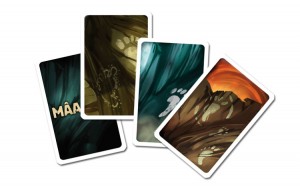Review: Mâamut
Posted by James (admin) on February 10th, 2011
 I noticed Mâamut in late 2009 but, unfortunately, I wasn’t able to buy a copy from the publisher until Spiel 2010. The game appealed to me because of the mammoth hunting theme and its simplicity.
I noticed Mâamut in late 2009 but, unfortunately, I wasn’t able to buy a copy from the publisher until Spiel 2010. The game appealed to me because of the mammoth hunting theme and its simplicity.
During the game, players use their 1 hunter (meeple) to lay traps and try to catch the one roaming Mammoth. A hexagonal board is assembled of randomly placed hex tiles each showing grass, snow or rocks. Players take turns taking one action which can be to either:
- Move – Play a card from their hand of 3 (valued 1 – 3) and move their hunter (a) the full number of spaces, (b) in a straight line, and (c) never on to/through rocks (as these are always out of bounds to hunters and mammoths).
- Lay trap – Place on their hunter’s current tile but only if it’s a grass tile (and no other hunters or traps are there)
- Remove opponent’s trap – If no other hunters are there.
- Pass – Discard a card and draw a new one.
If a player moves into the Mammoth’s space, the mammoth tries to run directly away from the hunter and moves the number of spaces marked on the player’s movement card. If the mammoth can not fully complete that movement it will take the next direction it can clockwise but never moving back towards the hunter. If the mammoth moves into a hunter’s space, the hunter moves to an adjacent space (not rocks) to avoid the charging mammoth (or they get trampled and are out of the game). If the mammoth moves onto a trap at any time, the player that owns the trap wins.
 Mâamut is such a simple game and can be taught in a few minutes. Whilst the rules are simple, the gameplay is a lot of fun and there’s definitely thinking required. It’s possible to use logic to create short-term strategies but, whilst you may have a great plan, you need to keep thinking because other players are usually disrupting it. The one luck dependent element is the card draw which can occasionally frustrate you by being unkind but this usually evens itself out.
Mâamut is such a simple game and can be taught in a few minutes. Whilst the rules are simple, the gameplay is a lot of fun and there’s definitely thinking required. It’s possible to use logic to create short-term strategies but, whilst you may have a great plan, you need to keep thinking because other players are usually disrupting it. The one luck dependent element is the card draw which can occasionally frustrate you by being unkind but this usually evens itself out.
You always want to use your action to chase the mammoth towards your trap, or away from others’, but you need to balance that with spending turns standing still to lay your own traps.
Removing other players’ traps is humorous and ensures players can’t just take up the best trap locations and guarantee a win. However, players do have the option to defend their own traps if they’re willing to keep their hunter on the trap in question.
Turns move very quickly so there’s almost little downtime. Depending upon the cunning (or stupidity) of the players, game length can vary – the box states 15-30 minutes but I think it’s usually less per game and better to play as many games as there are players so it lasts longer and any randomness of the tile layout and/or card draw is evened out.
 The random board provides good variety between the games. Also, the theme works well, is easy to envisage and the artwork is suitably prehistoric.
The random board provides good variety between the games. Also, the theme works well, is easy to envisage and the artwork is suitably prehistoric.
In the end, Mâamut is light but a lot of fast fun. I think it would be a great family game, but found it also works well with experienced gamers after a light break, or quick finisher. I’m pleased it was worth the wait.
James.
[Played with 3 players]

